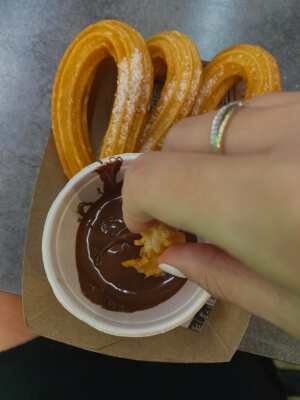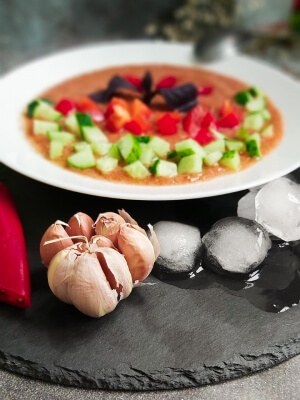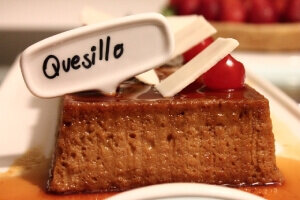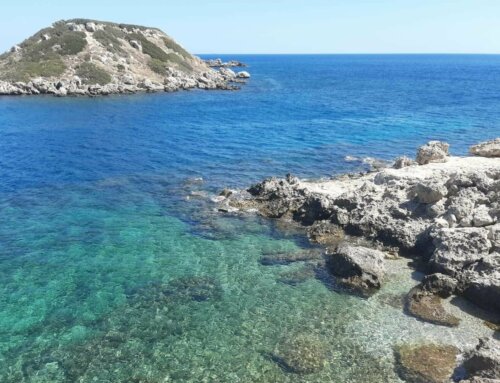Exploring the Spanish cuisine during your practical training in Spain
The Spanish cuisine is a combination of bold flavors, simple ingredients, and rich culinary traditions. From the big cities to the serene villages, your practical training in Spain offers a diverse range of dishes that represent the country’s culture, climate, and history. Spanish food is all about enjoying fresh, high-quality ingredients, prepared in ways that enhance their natural flavors. Whether you’re doing your practical training on the Spanish mainland, Mallorca, Ibiza or the Canary Islands, Spain’s iconic dishes are sure to delight and inspire your taste buds.
The heart of Spanish cooking: Fresh ingredients and simple techniques
At its core, Spanish cuisine relies on a few essential ingredients that are used across the country: olive oil, garlic, tomatoes, peppers, and a variety of fresh herbs. Olive oil, in particular, is a key element in almost every Spanish dish and serves as a base for cooking, dressing salads, and dipping bread.
In Spain, meals are often prepared with care and pride, whether it’s a simple lunchtime sandwich or a complex dish like paella. Spanish chefs focus on preserving the integrity of ingredients, using minimal seasoning to allow the natural flavors to shine through. This simplicity is key to the appeal of Spanish food. During your practical training in Spain, you will have the chance to experience the taste firsthand.
Iconic dishes of Spain: A must-try culinary experience during your practical training in Spain


Paella
No blog post about Spanish cuisine would be complete without mentioning paella, one of the most famous dishes in the world. Originating in the region of Valencia, paella is a rice dish that’s typically cooked with saffron, vegetables, and a variety of proteins. While seafood paella is perhaps the most well-known, it can also be made with chicken, rabbit, and even a mix of meats. The secret to a perfect paella lies in the rice, which should be tender yet slightly crispy at the bottom – a texture known as socarrat.
At most Spanish restaurants, paella is often served in the traditional wide, shallow pan it’s cooked in, making it a visually striking dish that invites sharing. Depending on the restaurant, it might be brought to the table in individual portions or as a large serving to be shared among a group. The rich aroma of saffron and grilled meats or seafood fills the air, enhancing the dining experience.
Although paella is often considered a festive dish, it’s enjoyed by people of all ages in Spain, especially during family gatherings and celebrations. So be sure to try paella during your practical training in Spain, it’s a culinary experience not to be missed.
Tortilla Española (Spanish omelet)
Another classic Spanish dish is the tortilla Española, also known as Spanish omelette. This dish is made with eggs, potatoes, and onions – often with a generous splash of olive oil. It can be served hot or cold and is a common choice for breakfast, lunch, or dinner. Whether served as a tapa (small appetizer) or as a full meal, tortilla Española represents comfort food in Spain. Some variations include the addition of chorizo, peppers, or other ingredients, but the classic version remains a favorite across the country. While doing your practical training in Spain, you’ll likely find tortilla Española on the menu at various restaurants and discover how it varies depending on regional preferences.


Tapas: A social culinary tradition
Tapas are small portions of food, often served alongside drinks, that embody the social spirit of Spanish dining. Tapas can range from simple snacks like olives, cheese, and cured meats to more elaborate dishes such as albóndigas (meatballs), gambas al ajillo (shrimps in garlic oil), and patatas bravas (fried potatoes with a spicy tomato sauce).
The beauty of tapas is in the variety. It’s a dining experience that encourages sharing and trying a little bit of everything. Whether you’re enjoying them at a local bar or served in a traditional restaurant, tapas offer a great introduction to the flavors of Spain. It’s also an ideal way to enjoy a relaxed, casual meal with friends or colleagues—something that is common during evenings in Spain. We are sure that during your practical training in Spain, you’ll have plenty of opportunities to enjoy tapas with fellow interns and colleagues.
Jamón Ibérico
You can’t visit Spain without tasting jamón ibérico, the prized cured ham made from black Iberian pigs. This delicacy is typically served thinly sliced and is often eaten as a tapa or appetizer. The flavor of jamón ibérico is rich and complex, with variations depending on how long the ham has been cured. The finest variety, jamón ibérico de bellota, comes from pigs that are fed a diet of acorns, which imparts a rich, nutty flavor to the ham.
It’s not uncommon to see a leg of jamón ibérico displayed in restaurants, supermarkets, and homes, where it is hand-carved. It’s a cultural symbol of Spain and a true delight for food lovers.


Churros con chocolate
For those with a sweet tooth, churros con chocolate is a beloved Spanish treat, often enjoyed at breakfast or as an afternoon snack. Churros are long, deep-fried pastry sticks, dusted with sugar, and served with a warm, thick chocolate sauce for dipping. The indulgence of churros paired with rich, velvety chocolate is the perfect way to start your day or enjoy a mid-afternoon treat. It’s common to enjoy churros with coffee or hot chocolate, and it’s a must-try during your practical training in Spain or during a language course in Málaga.
Gazpacho
As Spain’s summers can get quite hot, gazpacho is a refreshing and cooling dish that is particularly popular in southern Spain. This cold tomato-based soup is made with raw vegetables such as cucumbers, peppers, onions, and garlic, all blended together with olive oil, vinegar, and seasonings. The result is a smooth, chilled soup that’s perfect for cooling off during the warmer months. It’s not just a meal; it’s a Spanish tradition that brings the freshness of local produce to the table.
Drinks that complete the Spanish experience during your practical training in Spain
No meal in Spain is complete without a drink to accompany it. Here are some iconic Spanish beverages you should know about before you do your practical training in Spain:


Café
In Spain, coffee is an essential part of daily life, and it’s served in a variety of ways. When ordering a café, you’ll typically get an espresso. If you want a milder version, you can ask for a café con leche (espresso with milk) or a café cortado (a short espresso with a splash of milk). Another favorite is the café solo (single espresso), which is the most common choice for coffee lovers. Spanish coffee is often enjoyed alongside a sweet treat or a small pastry, particularly in the morning or afternoon.
Sangria and tinto de verano
For a refreshing and fruity drink, sangria is a popular choice, particularly during the summer months. This wine-based cocktail is made with red wine, fruit juices, soda water, fruit, and sometimes a splash of brandy. It’s served chilled and is ideal for relaxing on a warm evening.
While sangria has become a beloved drink worldwide, it holds a special place in Spanish culture, often associated with festive gatherings and family celebrations. The drink’s origins can be traced back to Spain, where it was traditionally made with local wines and fresh, seasonal fruits like oranges, lemons, and berries. Over time, it evolved into the colorful and flavorful beverage that we know today, with various regional variations depending on the area of Spain.
In Spanish restaurants, sangria is often served in large pitchers, making it perfect for sharing among friends and colleagues as part of your practical training in Spain.
Another beloved summer drink is tinto de verano, a simpler version of sangria, made with red wine and lemon soda or lemonade. It’s less sweet than sangria, making it a perfect option for those who prefer a lighter, more refreshing beverage.
Canarian cuisine: A flavorful journey through the Atlantic
While Spanish cuisine is incredibly diverse, the Canary Islands offer a distinct culinary experience that blends African, Latin American, and Spanish influences. Located off the northwest coast of Africa, the Canary Islands have their own unique food traditions that reflect the island’s geography, history, and cultural exchanges. As you explore the islands during your practical training in Spain, you’ll not only get to experience the culture and landscapes but also dive into the local flavors that make Canarian cuisine special.


For starters: Hearty soups to begin your meal
Canarian meals often start with soups that are both satisfying and flavorful, setting the stage for the rest of the meal. These hearty dishes reflect the islands’ rural and coastal lifestyle, making them the perfect introduction to local cuisine during your practical training in Spain.
Potaje de berros (Watercress soup)
A staple in Canarian cuisine, potaje de berros is a hearty soup made with fresh watercress, potatoes, beans, and chunks of pork or chorizo. This rustic dish boasts earthy, comforting flavors and is perfect for colder days on the island.
Rancho Canario
If you’re looking for something even heartier, rancho canario is the way to go. This thick soup combines noodles, chicken, pork, chickpeas, and a medley of vegetables. Filling and wholesome, it’s a reflection of the Canarian love for rustic and nourishing cooking.
Main courses: Signature dishes of the Canary Islands
The main courses in Canarian cuisine celebrate the islands’ natural bounty and rich culinary heritage. With access to both land and sea, Canarian meals often feature a perfect balance of fish, meats, and vegetables. Many dishes carry a long-standing history of local traditions, which you can explore during your practical training in the Canary Islands.
Papas arrugadas con mojos
Perhaps the most iconic dish of the Canary Islands, papas arrugadas are small, wrinkled potatoes boiled in heavily salted water, giving them a unique texture. Served with mojo verde (a fresh cilantro-based sauce) or mojo rojo (a spicy red pepper-based version), they are simple yet irresistible. You can find this dish during your hotel internship in Tenerife almost on every menu.
Gofio
Has been consumed since pre-Hispanic times by the Guanches, the indigenous people of the Canary Islands. It remains an emblematic food of Canarian identity. Making gofio involves roasting grains (or legumes) and grinding them into a fine flour. For many locals, it’s a comfort food associated with childhood, family, and tradition. While its preparation and pairing vary, it remains a beloved and nutritious staple on the Canary Islands.
Sancocho Canario
This traditional stew is a showcase of the islands’ fishing heritage. Made with salted fish (often cherne), potatoes, sweet potatoes, and corn, Sancocho Canario is usually served with a side of papas arrugadas, gofio and mojo rojo sauce. It’s a dish that embodies comfort and tradition.
Ropa Vieja Canaria
Translating to “old clothes”, Ropa Vieja is also a stew made from chicken, pork, or beef combined with vegetables, chickpeas, and potatoes. This dish is a beloved traditional dish in the Canary Islands, with its roots in Spanish and Latin American cuisine. The Canarian version often includes local touches that distinguish it from other variations found in Spain or Latin America.
Carne de cabra
Goat meat plays a significant role in the rural traditions of the Canary Islands. In carne de cabra, the meat is marinated with garlic, oregano, and bay leaves, then slow-cooked to tender perfection. This dish is particularly popular in the cooler months and pairs wonderfully with a robust local wine.
Sweet endings: Canarian desserts
No meal is complete without dessert, and Canarian cuisine offers a selection of sweet treats that delight the senses. After enjoying the savory dishes of the islands, these desserts are the perfect way to finish your meal and satisfy your sweet tooth.


Bienmesabe
Literally meaning “it tastes good to me,” Bienmesabe is a creamy, rich dessert made with ground almonds, sugar, egg yolks, and lemon zest. Often served as a mousse or paired with ice cream, this indulgent treat is a favorite among both locals and visitors.
Quesillo Canario
A Canarian twist on flan, quesillo is made with condensed milk, eggs, and caramelized sugar. Its creamy texture and sweet, comforting flavors make it a delightful way to finish your Canarian meal. Some variations include hints of vanilla or lemon zest for added depth.
Dining Out: The perfect way to immerse yourself in Spanish culture
Whether you’re or enjoying your internship in the Canary Islands or Spain’s mainland, the cuisine offers a rich tapestry of flavors that are both comforting and exciting. From the iconic paella to unique Canarian dishes, Spain’s food invites you to explore its history, culture, and traditions.
Don’t miss the opportunity to dive into the heart of Spanish cuisine during your practical training in Spain. You’ll find that the food is just as much a part of the experience as the places you visit. By dining out, you can gain valuable insights into the culture and its people. With so many delicious dishes to discover, we’re confident you’ll find yourself dining out often. We hope you savor every bite and enjoy this wonderful culinary adventure.
¡Buen provecho!













